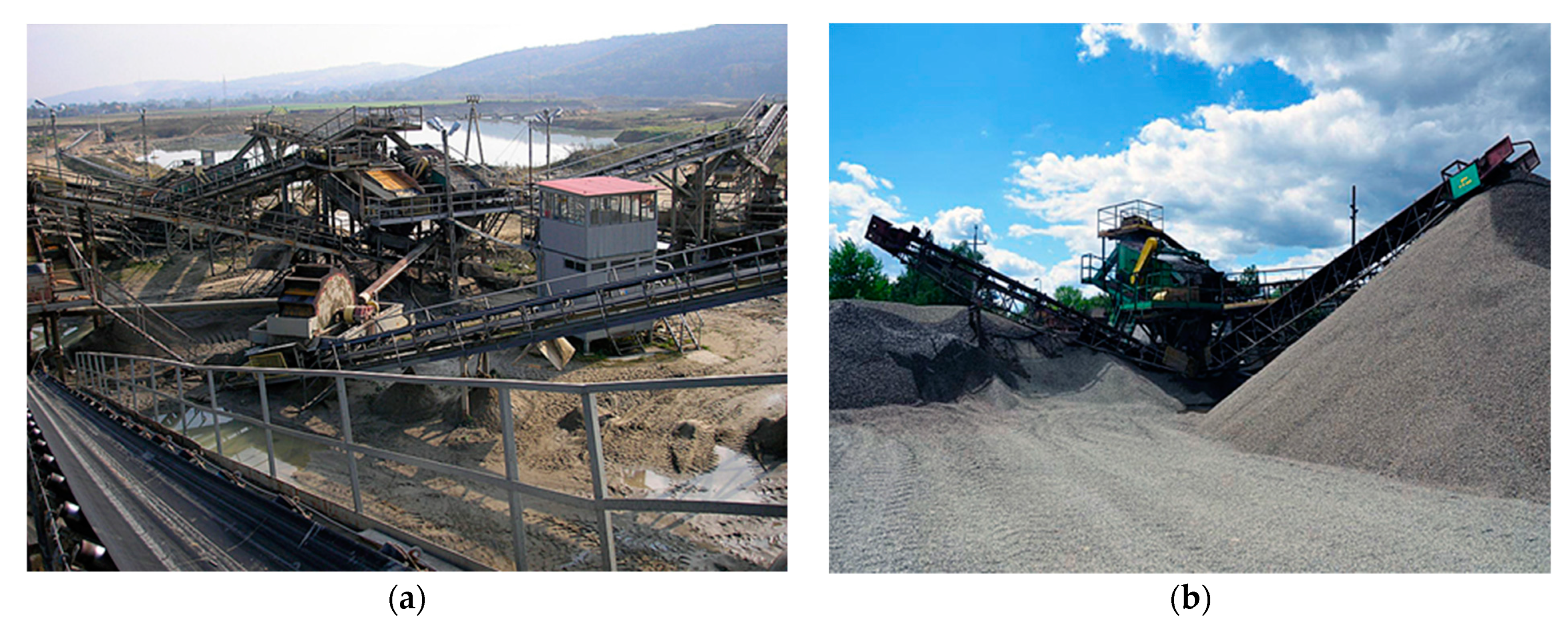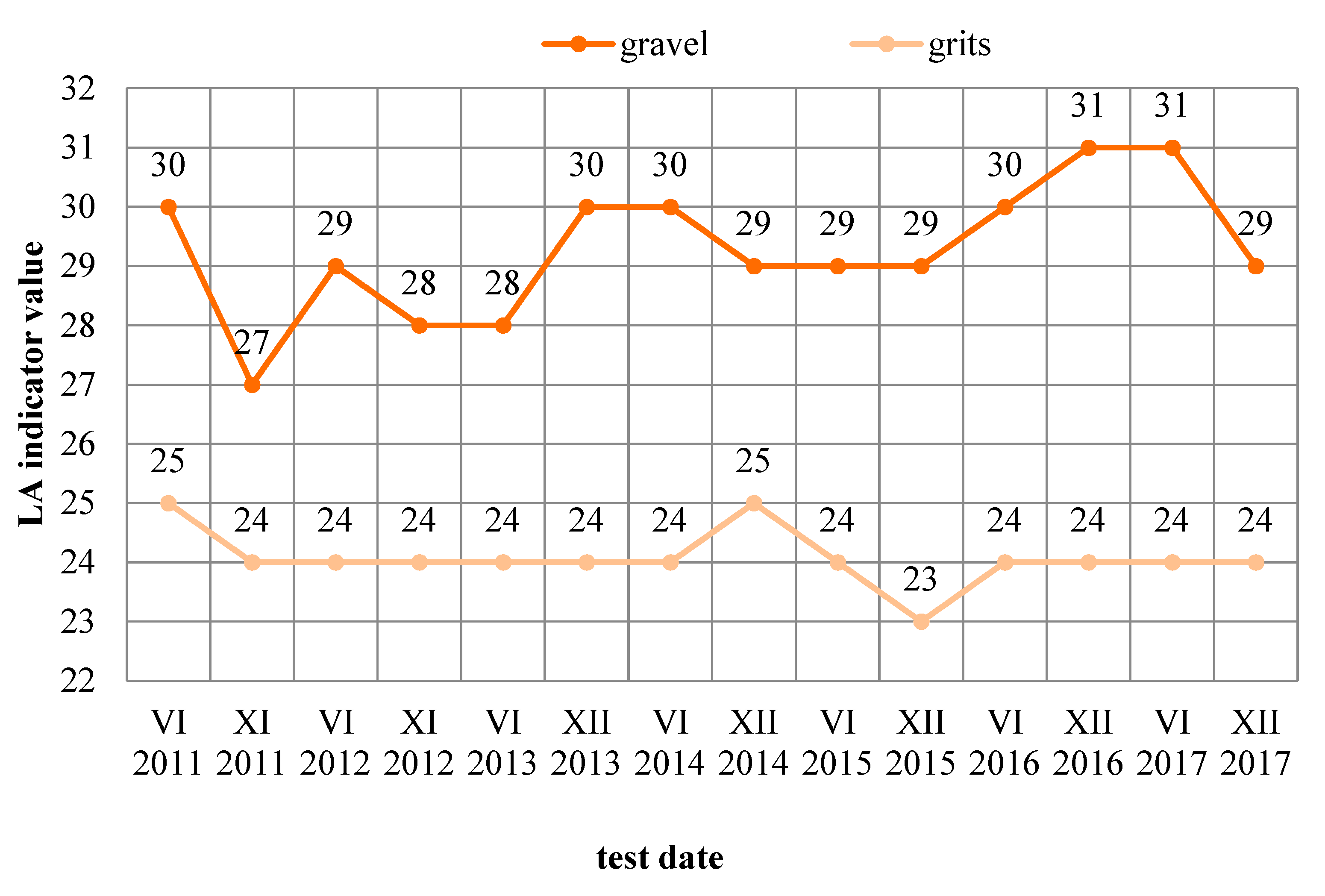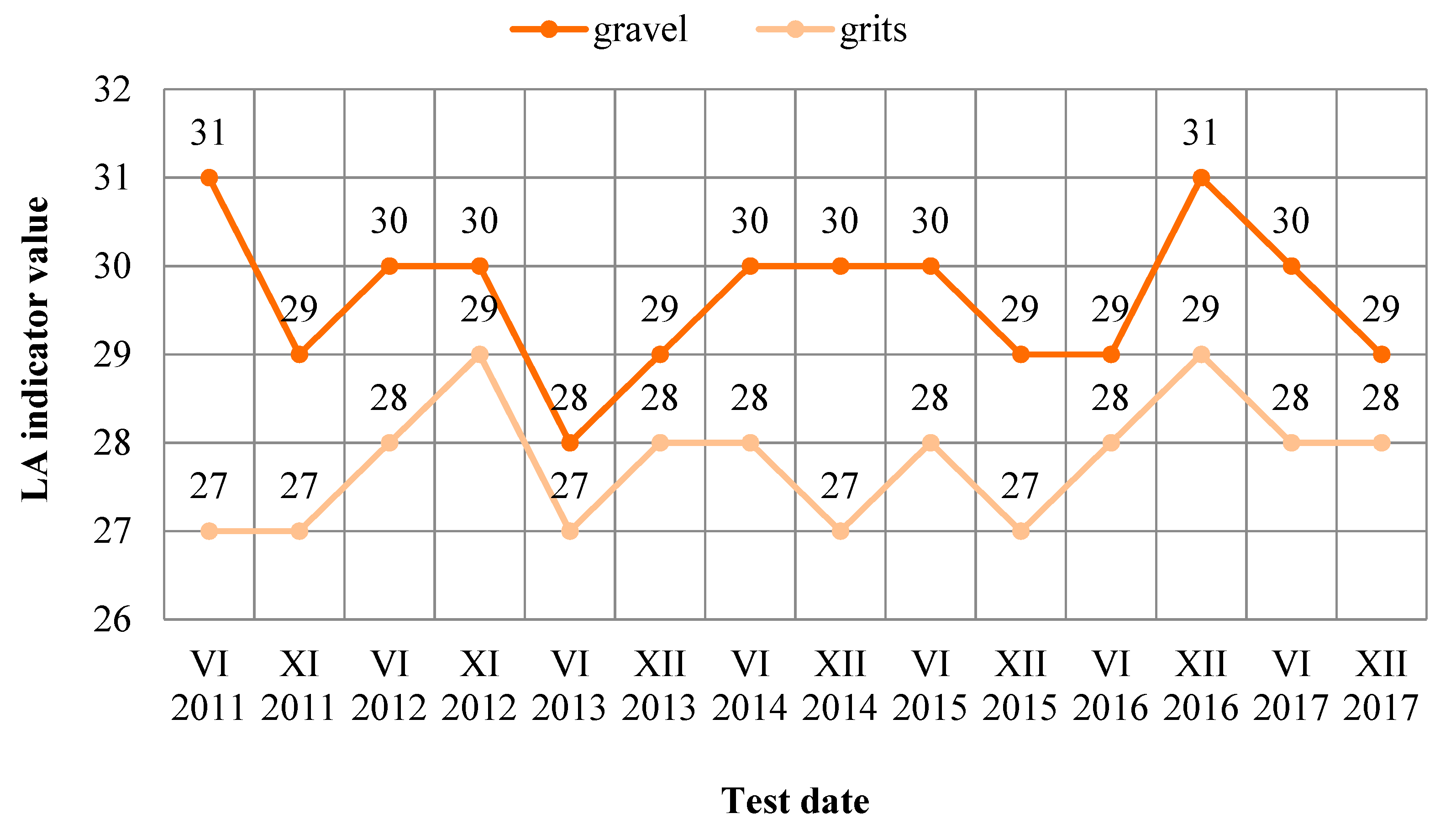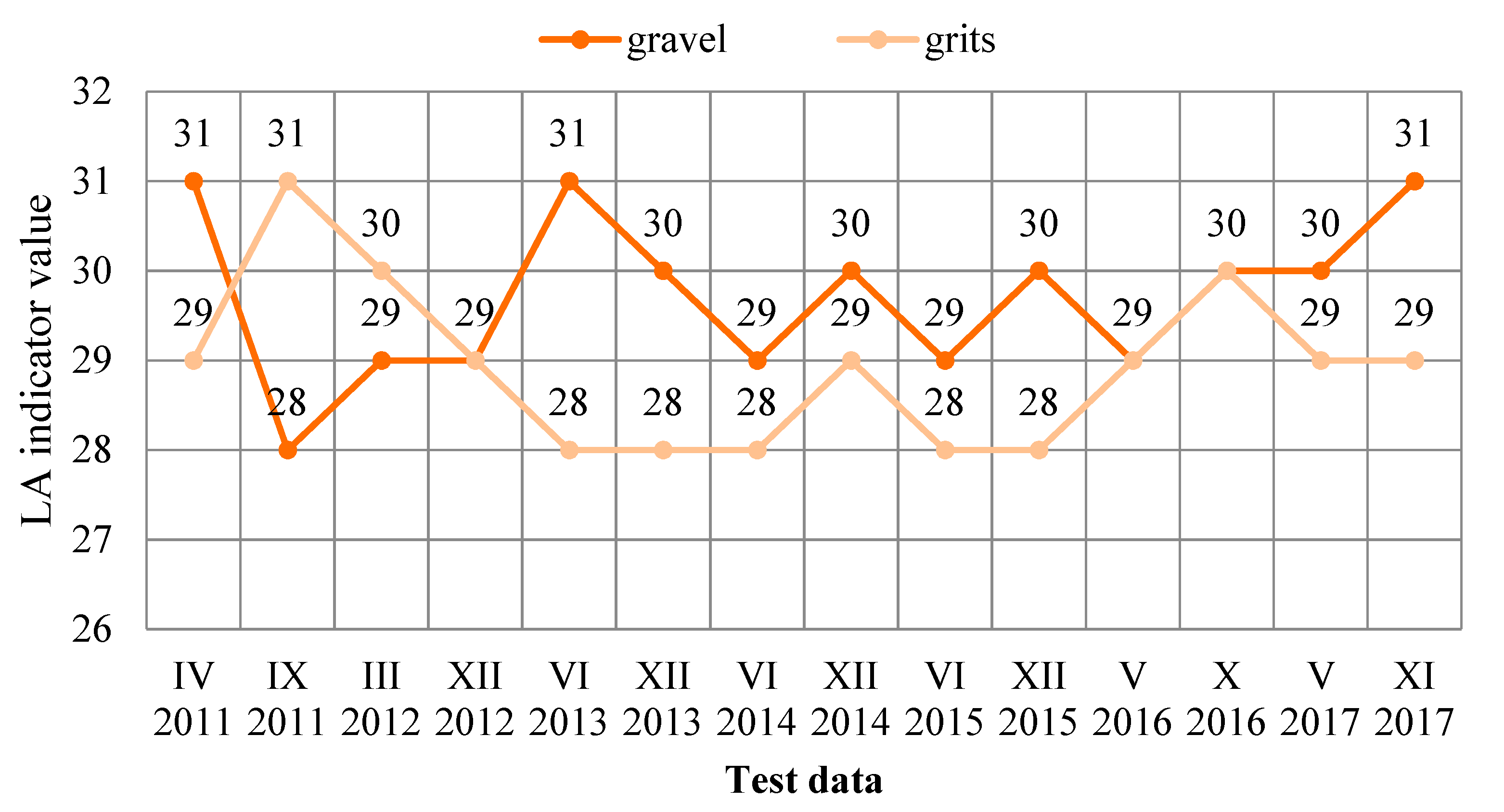Influence of Natural Aggregate Crushing Process on Crushing Strength Index
Abstract
1. Introduction
2. Literature Review
3. Materials
4. Methods
5. Results
5.1. Characteristics of Selected Facilities of Kruszgeo S.A.
5.2. Analysis of the Influence of a Production Process on the Aggregate Crushing Strength Index
6. Discussion
- In verified years for the selected fractions and plants, it turned out that for the different types of aggregate, the LAA index has different values in the range of 23–34%;
- For considered fractions 4–8 mm and 10–14 mm, the higher the fragmentation, the higher the LAA value, e.g., in verified years, the average index value of the smaller fraction (4–8 mm) for the analysis aggregate was lower at about 4%;
- In the fractions greater than 10–14 mm for grits, the LAA index has a high stability level, which is approximately 24%, irrespective of the plant;
- Grits are stable, independently from the plants, for the 4–8 mm fraction;
- Depending on the aggregate, the stability of the LAA index changed. For grits, it is more stable the bigger the fraction (10–14 mm), but for gravel, it is more stable the smaller the fraction (4–8 mm);
- In the case of grits, the lower the fraction, the higher the LLA index (about 24% and about 29%);
- The size of the fraction did not have a significant effect on the averaged crushing strength index for the gravel;
- The size of the fraction had a significant effect on the averaged crushing strength index for the grits; the smaller the fraction, the higher the LAA value.
7. Conclusions
Author Contributions
Funding
Institutional Review Board Statement
Informed Consent Statement
Data Availability Statement
Acknowledgments
Conflicts of Interest
References
- Langer, W. Sustainability of aggregates in construction. In Sustainability of Construction Materials, 2nd ed.; Woodhead Publishing: Sawston, UK, 2016; pp. 181–207. [Google Scholar]
- Gawenda, T. Problematyka doboru maszyn kruszących w instalacjach produkcji kruszyw mineralnych. Gór. Geoinżynieria 2010, 4, 195–208. [Google Scholar]
- Naziemiec, Z. Wpływ technologii przeróbki na jakość uzyskiwanego kruszywa. In Prace Instytutu Szkła, Ceramiki, Materiałów Ogniotrwałych i Budowlanych; Wydawnictwo Instytut Śląski Sp. z o.o.: Śląsk, Poland, 2009; pp. 183–193. [Google Scholar]
- Wittenberger, G.; Cehlar, M.; Simkova, Z. Deep hole drilling modern disintegration technologies in process of HDR technology 2013. Acta Montan. Slovaca 2012, 17, 241–246. [Google Scholar]
- Pacana, A.; Ulewicz, R. Research of determinants motiving to implement the environmental management system. Pol. J. Manag. Stud. 2017, 16, 165–174. [Google Scholar] [CrossRef]
- Nielsen, K.; Kristiansen, J. Blasting–crushing–grinding: Optimisation of an integrated comminution system. In Rock Fragmentation by Blasting; CRC Press: London, UK, 2020; pp. 269–277. [Google Scholar]
- Workman, L.; Eloranta, J. The effects of blasting on crushing and grinding efficiency and energy consumption. In Proceedings of the 29th Explosives and blasting technique conference (ISEE), Nashville, TN, USA, 2–5 February 2003; pp. 1–5. [Google Scholar]
- Lindqvist, M. Energy considerations in compressive and impact crushing of rock. Miner. Eng. 2008, 21, 631–641. [Google Scholar] [CrossRef]
- Ospanov, A.; Timurbekova, A. New hypothesis of energy of crushing. J. Hyg. Eng. Des. 2019, 27, 87–89. [Google Scholar]
- Laciak, M.; Sofranko, M. Designing of the technological line in the SCADA system PROMOTIC. In Proceedings of the 14th International Carpathian Control Conference, Rytro, Poland, 26–29 May 2013; pp. 202–207. [Google Scholar]
- Morrell, S. Predicting the overall specific energy requirement of crushing, high pressure grinding roll and tumbling mill circuits. Miner. Eng. 2009, 22, 544–549. [Google Scholar] [CrossRef]
- Rajan, B.; Singh, D. Understanding influence of crushers on shape characteristics of fine aggregates based on digital image and conventional techniques. Constr. Build. Mater. 2017, 150, 833–843. [Google Scholar] [CrossRef]
- Lee, E.; Evertsson, C.M. A comparative study between cone crushers and theoretically optimal crushing sequences. Miner. Eng. 2011, 24, 188–194. [Google Scholar] [CrossRef]
- Rosova, A.; Behun, M.; Khouri, S.; Cehlar, M.; Ferencz, V.; Sofranko, M. Case study: The simulation modeling to improve the efficiency and performance of production process. Wirel. Netw. 2020, 1–10. [Google Scholar] [CrossRef]
- Bengtsson, M.; Hulthen, E.; Evertsson, C.M. Size and shape simulation in a tertiary crushing stage, a multi objective perspective. Miner. Eng. 2015, 77, 72–77. [Google Scholar] [CrossRef]
- Kliment, M.; Trebuna, P.; Pekarcikova, M.; Straka, M.; Trojan, J.; Duda, R. Production efficiency evaluation and products’ quality improvement using simulation. Int. J. Simul. Model 2020, 3, 470–481. [Google Scholar] [CrossRef]
- Asbjörnsson, G.; Hulthén, E.; Evertsson, M. Modelling and dynamic simulation of gradual performance deterioration of a crushing circuit–Including time dependence and wear. Miner. Eng. 2012, 33, 13–19. [Google Scholar] [CrossRef]
- Ostroukh, A.; Surkova, N.; Varlamov, O.; Chernenky, V.; Baldin, A. Automated process control system of mobile crushing and screening plant. J. Appl. Eng. Sci. 2018, 16, 343–348. [Google Scholar] [CrossRef]
- Toraman, O.Y.; Kahraman, S.; Cayirli, S. Predicting the crushability of rocks from the impact strength index. Miner. Eng. 2010, 23, 752–754. [Google Scholar] [CrossRef]
- Köken, E.; Özarslan, A. New testing methodology for the quantification of rock crushability: Compressive crushing value (CCV). Int. J. Miner. Metall. Mater. 2018, 25, 1227–1236. [Google Scholar] [CrossRef]
- Molugaram, K.; Shanker, J.S.; Ramesh, A. A study on influence of shape of aggregate on strength and quality of concrete for buildings and pavements. Adv. Mater. Res. 2014, 941, 776–779. [Google Scholar] [CrossRef]
- Kekec, B.; Unal, M.; Sensogut, C. Effect of the textural properties of rocks on their crushing and grinding features. J. Univ. Sci. Technol. Beijing Miner. Metall. Mater. 2006, 13, 385–392. [Google Scholar] [CrossRef]
- Ovalle, C.; Frossard, E.; Dano, C.; Hu, W.; Maiolino, S.; Hicher, P.Y. The effect of size on the strength of coarse rock aggregates and large rockfill samples through experimental data. Acta Mech. 2014, 225, 2199–2216. [Google Scholar] [CrossRef]
- Piasta, W.; Góra, J.; Turkiewicz, T. Properties and durability of coarse igneous rock aggregates and concretes. Constr. Build. Mater. 2016, 126, 119–129. [Google Scholar] [CrossRef]
- Huang, Y.; He, X.; Sun, H.; Sun, Y.; Wang, Q. Effects of coral, recycled and natural coarse aggregates on the mechanical properties of concrete. Constr. Build. Mater. 2018, 192, 330–347. [Google Scholar] [CrossRef]
- Andrzejuk, W.; Barnathunej, D.; Gora, J. Physical Properties of Mineral and Recycled Aggregates Used to Mineral–Asphalt Mixtures. Materials 2019, 12, 3437. [Google Scholar] [CrossRef]
- Li, C.; Wang, F.; Deng, X.; Li, Y.; Zhao, S. Testing and Prediction of the Strength Development of Recycled–Aggregate Concrete with Large Particle Natural Aggregate. Materials 2019, 12, 1891. [Google Scholar] [CrossRef] [PubMed]
- Pacheco, J.N.; de Brito, J.; Chastre, C.; Evangelista, L. Probabilistic Conversion of the Compressive Strength of Cubes to Cylinders of Natural and Recycled Aggregate Concrete Specimens. Materials 2019, 12, 280. [Google Scholar] [CrossRef] [PubMed]
- Vaiana, R.; Balzano, F.; Iuele, T.; Gallelli, V. Microtexture Performance of EAF Slags Used as Aggregate in Asphalt Mixes: A Comparative Study with Surface Properties of Natural Stones. Appl. Sci. 2019, 9, 3197. [Google Scholar] [CrossRef]
- Ghanbari, M.; Abbasi, A.M.; Ravanshadnia, M. Production of natural and recycled aggregates: The environmental impacts of energy consumption and CO2 emissions. J. Mater. Cycles Waste Manag. 2018, 20, 810–822. [Google Scholar] [CrossRef]
- Pradhan, S.; Tiwari, B.R.; Kumar, S.; Barai, S.V. Comparative LCA of recycled and natural aggregate concrete using Particle Packing Method and conventional method of design mix. J. Clean. Prod. 2019, 228, 679–691. [Google Scholar] [CrossRef]
- Flegner, P.; Kacur, J.; Durdan, M.; Laciak, M. Evaluating noise sources in a working environment when disintegrating rocks by rotary drilling. Pol. J. Environ. Stud. PJOES 2019, 28, 3711–3720. [Google Scholar] [CrossRef]
- Martinez-Arguelles, G.; Paola, A.M.; Dugarte, M. Life Cycle Assessment of Natural and Recycled Concrete Aggregate Production for Road Pavements Applications in the Northern Region of Colombia: Case Study. Transp. Res. Rec. 2019, 2673, 397–406. [Google Scholar] [CrossRef]
- Al–Harthi, A.A. A field index to determine the strength characteristics of crushed aggregate. Bull. Eng. Geol. Environ. 2001, 60, 193–200. [Google Scholar] [CrossRef]
- Rangaraju, P.R.; Edlinski, J. Comparative evaluation of micro–deval abrasion test with other toughness/abrasion resistance and soundness tests. J. Mater. Civ. Eng. 2008, 20, 343–351. [Google Scholar] [CrossRef]
- Kahraman, S.; Fener, M. Predicting the Los Angeles abrasion loss of rock aggregates from the uniaxial compressive strength. Mater. Lett. 2007, 61, 4861–4865. [Google Scholar] [CrossRef]
- Palassi, M.; Danesh, A. Relationships between abrasion/degradation of aggregate evaluated from various tests and the effect of saturation. Rock Mech. Rock Eng. 2016, 49, 2937–2943. [Google Scholar] [CrossRef]
- Fookes, P.G.; Gourley, C.S.; Ohikere, C. Rock weathering in engineering time. Q. J. Eng. Geol. Hydrogeol. 1988, 21, 33–57. [Google Scholar] [CrossRef]
- Pacana, A.; Siwiec, D.; Bednárová, L. Method of Choice: A Fluorescent Penetrant Taking into Account Sustainability Criteria. Sustainability 2020, 12, 5854. [Google Scholar] [CrossRef]
- Siwiec, D.; Pacana, A. A Pro–Environmental Method of Sample Size Determination to Predict the Quality Level of Products Considering Current Customers’ Expectations. Sustainability 2021, 13, 5542. [Google Scholar] [CrossRef]
- Ulewicz, R.; Siwiec, D.; Pacana, A.; Tutak, M.; Brodny, J. Multi–Criteria Method for the Selection of Renewable Energy Sources in the Polish Industrial Sector. Energies 2021, 14, 2386. [Google Scholar] [CrossRef]
- Siwiec, D.; Pacana, A. Method of improve the level of product quality. Prod. Eng. Arch. 2021, 27, 1–7. [Google Scholar] [CrossRef]
- Pacana, A.; Siwiec, D.; Bednarova, L. Analysis of the incompatibility of the product with fluorescent method. Metallurgija 2019, 58, 337–340. [Google Scholar]
- Kruszgeo, S.A. Available online: http://www.kruszgeo.com.pl (accessed on 11 November 2020).
- Kazi, A.; Al–Mansour, Z.R. Influence of geological factors on abrasion and soundness characteristics of aggregates. Eng. Geol. 1980, 15, 195–203. [Google Scholar] [CrossRef]
- Erichsen, E.; Ulvik, A.; Sævik, K. Mechanical degradation of aggregate by the Los Angeles–, the micro–Deval–and the Nordic test methods. Rock Mech. Rock Eng. 2011, 44, 333. [Google Scholar] [CrossRef]
- Ballivy, G.; Dayre, M. The mechanical behaviour of aggregates related to physicomechanical properties of rocks. Int. Assoc. Eng. Geol. Bull. 1984, 29, 339–342. [Google Scholar]
- Cargill, J.S.; Shakoor, A. Evaluation of empirical methods for measuring the uniaxial compressive strength of rock. Int. J. Rock Mech. Min. Sci. Geomech. Abstr. 1990, 27, 495–503. [Google Scholar] [CrossRef]
- Fener, M.; Kahraman, S.; Ozder, M.O. Performance prediction of circular diamond saws from mechanical rock properties in cutting carbonate rocks. Rock Mech. Rock Eng. 2007, 40, 505–517. [Google Scholar] [CrossRef]
- Ugur, I.; Demirdag, S.; Yavuz, H. Effect of rock properties on the Los Angeles abrasion and impact test characteristics of the aggregates. Mater. Charact. 2010, 61, 90–96. [Google Scholar] [CrossRef]
- Ozcelik, Y. Predicting Los Angeles abrasion of rocks from some physical and mechanical properties. Sci. Res. Essay 2011, 6, 1612–1616. [Google Scholar]
- Okonta, F.N. Relationships between abrasion index and shape properties of progressively abraded dolerite railway ballasts. Rock Mech. Rock Eng. 2014, 47, 1335–1344. [Google Scholar] [CrossRef]
- Hydzik–Winiewska, J. The relationship between the mechanical properties of aggregates and their geometric parameters on the example of Polish Carpathian Sandstones. Arch. Civ. Eng. 2020, 66, 209–223. [Google Scholar] [CrossRef]
- Adom–Asamoah, M.; Afrifa, R.O. A study of concrete properties using phyllite as coarse aggregates. Mater. Des. 2010, 31, 4561–4566. [Google Scholar] [CrossRef]
- Omary, S.; Ghorbel, E.; Wardeh, G. Relationships between recycled concrete aggregates characteristics and recycled aggregates concretes properties. Constr. Build. Mater. 2016, 108, 163–174. [Google Scholar] [CrossRef]
- Kamani, M.; Ajalloeian, R. Evaluation of the mechanical degradation of carbonate aggregate by rock strength tests. J. Rock Mech. Geotech. Eng. 2019, 11, 121–134. [Google Scholar] [CrossRef]
- Islam, J.; Alam, R.; Islam, M.; Hasanuzzaman, M. Evaluation of commonly used aggregates for sustainable infrastructure development in Bangldesh. Int. J. Geomate 2020, 18, 98–104. [Google Scholar] [CrossRef]
- Khanlari, G.R.; Naseri, F. Predicition of aggregate modified index (AMI) using geomechanical properties of limestones. Bull. Eng. Geol. Environ. 2018, 77, 803–814. [Google Scholar] [CrossRef]
- Omowumi, A. Engineering geological evaluation of some rocks from Akure, Southwestern Nigeria as aggregates for concrete and pavement construction. Geol. Geophys. Environ. 2019, 45, 31–43. [Google Scholar] [CrossRef]
- Bulevicius, M.; Petkevicius, K.; Zilioniene, D.; Cirba, S. Testing Of Mechanical–Physical Properties Of Aggregates, Used For Producing Asphalt Mixtures, And Statistical Analysis Of Test Results. Balt. J. Road Bridge Eng. 2011, 6, 115–123. [Google Scholar] [CrossRef]
- Naeem, M.; Khalid, P.; Anwar, A. Construction material prospects of granitic and associated rocks of Mansehra area, NW Himalaya, Pakistan. Acta Geod. Geophys. 2015, 50, 307–319. [Google Scholar] [CrossRef][Green Version]
- Afolagboye, L.O.; Talabi, A.O.; Akinola, O.O. Evaluation of selected basement complex rocks from Ado–Ekiti, SW Nigeria, as source of road construction aggregates. Bull. Eng. Geol. Environ. 2016, 75, 853–865. [Google Scholar] [CrossRef]






| ZEK Ostrów | |||
|---|---|---|---|
| Fraction | Test Date | Gravel | Grits |
| 10–14 mm | VI 2011 | 30 | 25 |
| XI 2011 | 27 | 24 | |
| VI 2012 | 29 | 24 | |
| XI 2012 | 28 | 24 | |
| VI 2013 | 28 | 24 | |
| XII 2013 | 30 | 24 | |
| VI 2014 | 30 | 24 | |
| XII 2014 | 29 | 25 | |
| VI 2015 | 29 | 24 | |
| XII 2015 | 29 | 23 | |
| VI 2016 | 30 | 24 | |
| XII 2016 | 31 | 24 | |
| VI 2017 | 31 | 24 | |
| XII 2017 | 29 | 24 | |
| ZEK Strzegocice II | |||
|---|---|---|---|
| Fraction | Test Date | Gravel | Grits |
| 10–14 mm | IV 2011 | 30 | 25 |
| IX 2011 | 30 | 24 | |
| III 2012 | 30 | 24 | |
| XII 2012 | 29 | 24 | |
| VI 2013 | 29 | 24 | |
| XII 2013 | 32 | 24 | |
| VI 2014 | 31 | 24 | |
| XII 2014 | 32 | 25 | |
| VI 2015 | 32 | 24 | |
| XII 2015 | 31 | 23 | |
| V 2016 | 34 | 24 | |
| X 2016 | 33 | 24 | |
| V 2017 | 33 | 24 | |
| XI 2017 | 32 | 24 | |
| ZEK Ostrów | |||
|---|---|---|---|
| Fraction | Test Date | Gravel | Grits |
| 4–8 mm | VI 2011 | 31 | 27 |
| XI 2011 | 29 | 27 | |
| VI 2012 | 30 | 28 | |
| XI 2012 | 30 | 29 | |
| VI 2013 | 28 | 27 | |
| XII 2013 | 29 | 28 | |
| VI 2014 | 30 | 28 | |
| XII 2014 | 30 | 27 | |
| VI 2015 | 30 | 28 | |
| XII 2015 | 29 | 27 | |
| VI 2016 | 29 | 28 | |
| XII 2016 | 31 | 29 | |
| VI 2017 | 30 | 28 | |
| XII 2017 | 29 | 28 | |
| ZEK Strzegocice II | |||
|---|---|---|---|
| Fraction | Test Date | Gravel | Grits |
| 4–8 mm | IV 2011 | 31 | 29 |
| IX 2011 | 28 | 31 | |
| III 2012 | 29 | 30 | |
| XII 2012 | 29 | 29 | |
| VI 2013 | 31 | 28 | |
| XII 2013 | 30 | 28 | |
| VI 2014 | 29 | 28 | |
| XII 2014 | 30 | 29 | |
| VI 2015 | 29 | 28 | |
| XII 2015 | 30 | 28 | |
| V 2016 | 29 | 29 | |
| X 2016 | 30 | 30 | |
| V 2017 | 30 | 29 | |
| XI 2017 | 31 | 29 | |
Publisher’s Note: MDPI stays neutral with regard to jurisdictional claims in published maps and institutional affiliations. |
© 2021 by the authors. Licensee MDPI, Basel, Switzerland. This article is an open access article distributed under the terms and conditions of the Creative Commons Attribution (CC BY) license (https://creativecommons.org/licenses/by/4.0/).
Share and Cite
Pacana, A.; Siwiec, D.; Bednarova, L.; Sofranko, M.; Vegsoova, O.; Cvoliga, M. Influence of Natural Aggregate Crushing Process on Crushing Strength Index. Sustainability 2021, 13, 8353. https://doi.org/10.3390/su13158353
Pacana A, Siwiec D, Bednarova L, Sofranko M, Vegsoova O, Cvoliga M. Influence of Natural Aggregate Crushing Process on Crushing Strength Index. Sustainability. 2021; 13(15):8353. https://doi.org/10.3390/su13158353
Chicago/Turabian StylePacana, Andrzej, Dominika Siwiec, Lucia Bednarova, Marian Sofranko, Olga Vegsoova, and Martin Cvoliga. 2021. "Influence of Natural Aggregate Crushing Process on Crushing Strength Index" Sustainability 13, no. 15: 8353. https://doi.org/10.3390/su13158353
APA StylePacana, A., Siwiec, D., Bednarova, L., Sofranko, M., Vegsoova, O., & Cvoliga, M. (2021). Influence of Natural Aggregate Crushing Process on Crushing Strength Index. Sustainability, 13(15), 8353. https://doi.org/10.3390/su13158353









